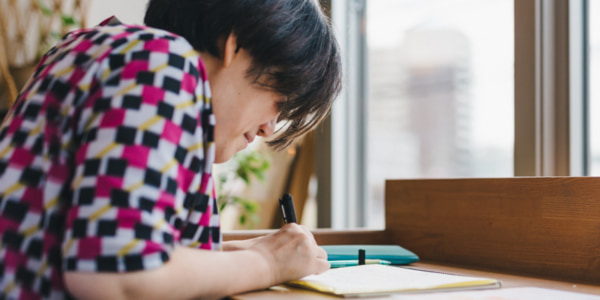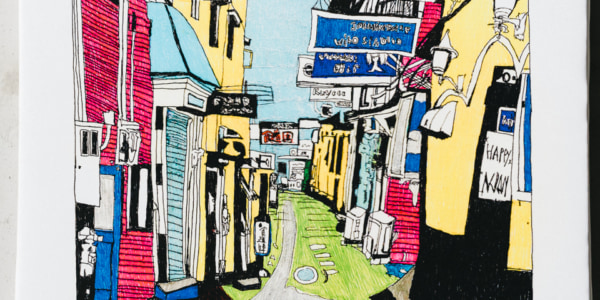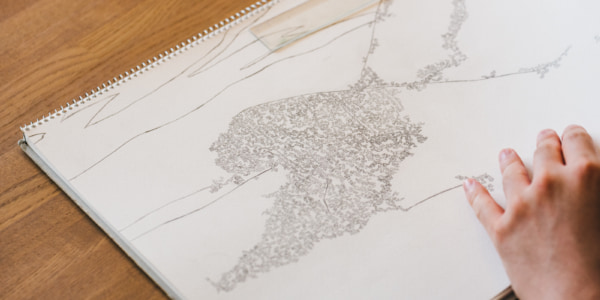Somewhere in between roundness and edginess:
Capturing an outline that’s “just right”
There’s the Sasebo River and the Albuquerque Bridge that spans it. Sasebo Park and Nimitz Park lie beyond the river. MINATOMACHI FACTORY can be found on the second floor of a building surrounded by water and greenery in Sasebo City, Nagasaki Prefecture. Megumi’s usual spot is a seat by the window overlooking this expansive view, which makes her feel equally expansive. Here, megumi calmly and slowly glides her felt-tipped pen across her sketchbook.
![[Photograph]](https://www.diversity-in-the-arts.jp/admin/wp-content/uploads/2022/08/img_megumi-03.jpg)
Megumi working on a line drawing in a calm, detached manner
The shipyard, foreigner-friendly bars, and Gunkanjima (Hashima Island). The lantern festival and the Sasebo Burger. Many of megumi’s works feature views and food from Sasebo. Staff select the photographs and suggest them to her. With her personal touch, megumi adds new contours to familiar scenes and objects. Her outlines give off a charming and warm impression.
“Any motif can become an interesting work of art through megumi’s filter.”
TANAKA Satoko, a staff member who supports megumi’s creative activities, told us this.
![[Photograph]](https://www.diversity-in-the-arts.jp/admin/wp-content/uploads/2022/08/img_megumi-04.jpg)
Staff member TAKANA Satoko (right) gently oversees megumi’s creative process. Tanaka also suggests the motifs that megumi draws and designs textiles that incorporate her illustrations.
On the day of our visit, she was drawing desserts and drinks from a coffee shop called Komeda’s Coffee. While looking at a photo of pie pastries topped with soft-serve ice cream and a mug filled with coffee, megumi grasps an outline that’s “just right,” somewhere in between roundness and edginess, and converts it into a line drawing.
![[Photograph]](https://www.diversity-in-the-arts.jp/admin/wp-content/uploads/2022/08/img_megumi-05.jpg)
Using a felt-tipped pen, she slowly traces the sketch she drew while looking at the photo.
![[Photograph]](https://www.diversity-in-the-arts.jp/admin/wp-content/uploads/2022/08/img_megumi-06.jpg)
The line drawing is complete! It’s ready to be scanned to the computer for coloring.
The fun of creating works in different colors, made possible by the computer
To add color, megumi scans her line drawings to a computer and colors them in using Adobe’s Illustrator software. She is skilled at using the Live Paint feature and applies the colors quickly and efficiently. The way in which she works has an artisan-like quality. She has tried coloring with colored pencils and crayons in the past, but ultimately settled on this method.
![[Photograph]](https://www.diversity-in-the-arts.jp/admin/wp-content/uploads/2022/08/img_megumi-07.jpg)
After converting her line drawings into data using Adobe’s Photoshop software, megumi uses Illustrator’s Live Paint function to apply colors.
The colors in the first version are based on the original photo. From the second version onwards, her coloring follows an entirely unique approach—the soft-serve ice cream may be pink, while the face of a person is green or purple. If the original photo is in black and white, the first version will be in megumi’s own colors.
![[Photograph]](https://www.diversity-in-the-arts.jp/admin/wp-content/uploads/2022/08/img_megumi-08.jpg)
Megumi quickly applies the colors by copying and pasting them to areas that use the same colors.
![[Photograph]](https://www.diversity-in-the-arts.jp/admin/wp-content/uploads/2022/08/img_megumi-09.jpg)
The first colored version is nearly complete. After this, she will move on to coloring the second version.
![[Photograph]](https://www.diversity-in-the-arts.jp/admin/wp-content/uploads/2022/08/img_megumi-10.jpg)
From the second version onwards, megumi’s drawings take on unique color combinations that draw us deeper into her unique world.
She also has a series of reproductions of famous paintings. Compositions by Munch, Vermeer, and Botticelli are combined with megumi’s free and vigorous coloring, creating scenes that are both familiar and unfamiliar to the viewer. This momentarily baffles our brains, and then, gradually, we start to think, “how wonderful,” or “how interesting.” It has the effect of expanding the viewer’s frame of thinking a little. Megumi’s standard practice is to create four or so versions in different colors. When the four versions are lined up, the colors gradually shift from those of the real world to those that only exist in megumi’s inner world, creating a strange sense of movement.
The path to becoming a professional illustrator opened up unexpectedly
MINATOMACHI FACTORY is equipped with a garment printer that can print images directly on fabric. Once they are completed, megumi’s works are quickly printed on fabric on the spot and then sent to the nearby SASEBO CLOTH & ACCESSORY FACTORY, which is run by the same company, where they are cut and sewn into pouches, handkerchiefs, and other cloth products. Textiles designed by the staff that incorporate parts of illustrations into patterns are also made into bags and pouches.
Megumi is also adept at light work such as cutting out and assembling the paper backing of the packages for these products using a utility knife, which she does from time to time.
![[Photograph]](https://www.diversity-in-the-arts.jp/admin/wp-content/uploads/2022/08/img_megumi-12.jpg)
A pattern designed by staff member Tanaka using parts of megumi’s illustrations. Fabric printed with this pattern is used to create pouches and bags. The motif in this design is the Kujuku Islands.
![[Photograph]](https://www.diversity-in-the-arts.jp/admin/wp-content/uploads/2022/08/img_megumi-13.jpg)
Bags and pouches made from textiles designed using parts of megumi’s illustrations.
Megumi frequented several different facilities prior to MINATOMACHI FACTORY, but this was the first place she has stayed at for a long time. It has been about nine years since she began coming here. At first, she intended to learn Excel and Word, hoping to acquire useful skills for employment.
However, when a staff member encouraged her to try drawing, the illustrations she created were a hit. She entered her illustrations in a public contest organized by Komeda’s Coffee and was selected as the winner. These illustrations were used on the packaging of soybean snacks and turned into posters for franchisees to display in their stores. The posters, which were issued with serial numbers and limited to 100 copies, completely sold out. Her business cards are also popular; for these, she draws the client’s portrait, and the design is finished at MINATOMACHI FACTORY.
![[Photograph]](https://www.diversity-in-the-arts.jp/admin/wp-content/uploads/2022/08/img_megumi-14.jpg)
Soybean snack packages from Komeda’s Coffee featuring megumi’s illustrations. In 2020, four packages were made for each season and served with coffee at shops nationwide for one year.
Currently, megumi commutes to MINATOMACHI FACTORY two days a week. On the other days, she works at home, importing her drawings to her computer and coloring them in a work-from-home arrangement.
Megumi told us in a few words that she was happy that her work had been chosen for the packaging and posters at Komeda’s Coffee, but that she had yet to actually visit the coffee shop. She seems to be a true artisan after all.
![[Works]](https://www.diversity-in-the-arts.jp/admin/wp-content/uploads/2022/08/img_megumi-15.jpg)
《Komeda’s Coffee》/ Sketchbook, felt-tipped pen, digital coloring / 287×202mm / 2019
Among her works was a reproduction of Van Gogh’s self-portrait. Van Gogh’s portraits can give off a strong impression of gloominess, perhaps because the artist’s gloomy story is imprinted in our minds. In Megumi’s reproduction, however, Van Gogh had a much brighter expression. Besides,
“This Van Gogh doesn’t have a sleeve, you know.”
SAKAI Kayo, a staff member, shared this information on the sly. Van Gogh is wearing a jacket in the original painting, but in megumi’s version, his arm is bare from the shoulder down. Van Gogh looks a little more cheerful in sleeveless attire. Once again, we felt a sense of delight as this image expanded our narrow frames of mind.
![[Photograph]](https://www.diversity-in-the-arts.jp/admin/wp-content/uploads/2022/08/img_megumi-20.jpg)
Under megumi’s influence, staff member Tanaka (right) started to draw illustrations herself. Some of her works have been adopted for use in MINATOMACHI FACTORY products.




![[Photograph]目の前に川と緑が見える、いつもの席で制作中のmegumiさん](https://www.diversity-in-the-arts.jp/admin/wp-content/uploads/2022/08/img_megumi-01.jpg)
![[Works]港のある佐世保の風景を描いた作品。船の基部は青に、海と空は落ち着いた青で塗られたパターン](https://www.diversity-in-the-arts.jp/admin/wp-content/uploads/2022/08/img_megumi-02a.jpg)
![[Works]船は黄色一色に、海と空はマゼンダ寄りの紫色に塗られたパターン](https://www.diversity-in-the-arts.jp/admin/wp-content/uploads/2022/08/img_megumi-02b.jpg)
![[Works]船の基部は赤に、海と空は明るい青に塗られたパターン](https://www.diversity-in-the-arts.jp/admin/wp-content/uploads/2022/08/img_megumi-02c.jpg)
![[Works]佐世保に立ち並ぶ、外国人向けのバー店内のイラスト。ピンクを基調としたパターン](https://www.diversity-in-the-arts.jp/admin/wp-content/uploads/2022/08/img_megumi-11a-2.jpg)
![[Works]黒と赤を基調としたパターン](https://www.diversity-in-the-arts.jp/admin/wp-content/uploads/2022/08/img_megumi-11b-2.jpg)
![[Works]青を基調としたパターン](https://www.diversity-in-the-arts.jp/admin/wp-content/uploads/2022/08/img_megumi-11c-2.jpg)
![[Photograph]](https://www.diversity-in-the-arts.jp/admin/wp-content/uploads/2022/08/img_megumi-16a.jpg)
![[Photograph]名画カードケース](https://www.diversity-in-the-arts.jp/admin/wp-content/uploads/2022/08/img_megumi-16b.jpg)
![[Works]クレーンが並ぶ、佐世保の造船所を描いた作品。4つの色違いパターンがある。](https://www.diversity-in-the-arts.jp/admin/wp-content/uploads/2022/08/img_megumi-17.jpg)
![[Works]長崎市にある端島、通称「軍艦島」を俯瞰で描いた作品。色を塗る前の線画のオリジナル](https://www.diversity-in-the-arts.jp/admin/wp-content/uploads/2022/08/img_megumi-18a-960x720.jpg)
![[Works]海は落ち着いた青、島はグレーを基調にしたパターン](https://www.diversity-in-the-arts.jp/admin/wp-content/uploads/2022/08/img_megumi-18b.jpg)
![[Works]海は暗いうぐいす色、島は茶色を基調にしたパターン](https://www.diversity-in-the-arts.jp/admin/wp-content/uploads/2022/08/img_megumi-18c.jpg)
![[Works]海は暗い赤、島はレモンイエローを基調にしたパターン](https://www.diversity-in-the-arts.jp/admin/wp-content/uploads/2022/08/img_megumi-18d.jpg)
![[Works]提灯が並ぶ、長崎ランタンフェスティバルの様子を描いたイラスト。色を塗る前の線画のオリジナル](https://www.diversity-in-the-arts.jp/admin/wp-content/uploads/2022/08/img_megumi-19a-960x720.jpg)
![[Works]黄色と赤をメインにしたパターン](https://www.diversity-in-the-arts.jp/admin/wp-content/uploads/2022/08/img_megumi-19b.jpg)
![[Works]黄色とグレーをメインにしたパターン](https://www.diversity-in-the-arts.jp/admin/wp-content/uploads/2022/08/img_megumi-19c.jpg)
![[Works]手前の提灯が黄色と青や赤、緑のストライプになっているパターン](https://www.diversity-in-the-arts.jp/admin/wp-content/uploads/2022/08/img_megumi-19d.jpg)
![[Works]明るい黄色をメインにしたパターン](https://www.diversity-in-the-arts.jp/admin/wp-content/uploads/2022/08/img_megumi-19e.jpg)


